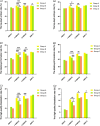Effects of total gonadotropin dose on embryo quality and clinical outcomes with AMH stratification in IVF cycles: a retrospective analysis of 12,588 patients
- PMID: 38475829
- PMCID: PMC10929233
- DOI: 10.1186/s40001-024-01768-w
Effects of total gonadotropin dose on embryo quality and clinical outcomes with AMH stratification in IVF cycles: a retrospective analysis of 12,588 patients
Abstract
Background: Recent studies about the effect of gonadotropin (Gn) dose on the clinical outcomes of IVF are still controversial, and no studies have analyzed the relationship between Gn dose and embryo quality. Since AMH is a strong predictor of oocyte quality, we aim to evaluate the relationship between total Gn dose and embryo quality and clinical outcomes at different AMH levels in IVF cycles.
Methods: A total of 12,588 patients were enrolled in the retrospective study. The included cycles were categorized by serum AMH levels (AMH ≤ 1 ng/ml, 1 ng/ml < AMH ≤ 3 ng/ml, 3 ng/ml < AMH ≤ 5 ng/ml, AMH > 5 ng/ml), total Gn dosage (< 1875 IU, 1875-3750 IU and ≥ 3750 IU) and female age (< 35 years and 35-42 years). The embryo quality and clinical outcomes were the measure outcomes.
Results: The top-day3 embryos rate decreased with the increase of total Gn dose in nearly all age and AMH subgroups, but this trend was not obvious in the AMH > 5 ng/ml group and AMH ≤ 1 ng/ml group. The blastocyst formation rate and high-quality blastulation rate had a negative relationship with Gn does for women aged < 35 years in the AMH ≤ 5 ng/ml groups, except for the AMH > 5 ng/ml group (P < 0.001). However, when women were 35-42 years old, regardless of AMH levels, the blastocyst formation rate and high-quality blastulation rate decreased as Gn dose increased. Clinical outcomes (implantation rate, clinical pregnancy rate and live birth rate) decreased with the increase of Gn dose in all ages and AMH stratifications.
Conclusions: The total dose of Gn may have different effects on embryo quality at different serum AMH levels, and the negative effects of total dose of Gn on clinical outcomes may be realized by impairing both embryo quality and endometrium.
Keywords: Anti-Müllerian hormone; Clinical outcomes; Embryo quality; Gonadotropin; In vitro fertilization.
© 2024. The Author(s).
Conflict of interest statement
The authors declare that they have no competing interests.
Figures



Similar articles
-
Predictive value of anti-Mullerian hormone for pregnancy outcomes following assisted reproductive techniques (ART) in Southwest China.Reprod Health. 2022 Dec 13;19(1):224. doi: 10.1186/s12978-022-01524-5. Reprod Health. 2022. PMID: 36514055 Free PMC article.
-
Differential impact of controlled ovarian hyperstimulation on live birth rate in fresh versus frozen embryo transfer cycles: a Society for Assisted Reproductive Technology Clinic Outcome System study.Fertil Steril. 2020 Dec;114(6):1225-1231. doi: 10.1016/j.fertnstert.2020.06.021. Epub 2020 Oct 2. Fertil Steril. 2020. PMID: 33012553
-
[Value of anti-Müllerian hormone and age in predicting pregnancy outcomes of in vitro fertilization and embryo transfer treatment].Zhonghua Fu Chan Ke Za Zhi. 2019 Apr 25;54(4):239-244. doi: 10.3760/cma.j.issn.0529-567x.2019.04.005. Zhonghua Fu Chan Ke Za Zhi. 2019. PMID: 31006189 Chinese.
-
Oocyte matched follicular fluid anti-Müllerian hormone is an excellent predictor of live birth after fresh single embryo transfer.Hum Reprod. 2019 Nov 1;34(11):2244-2253. doi: 10.1093/humrep/dez186. Hum Reprod. 2019. PMID: 31725884
-
AMH has no role in predicting oocyte quality in women with advanced age undergoing IVF/ICSI cycles.Sci Rep. 2020 Nov 12;10(1):19750. doi: 10.1038/s41598-020-76543-y. Sci Rep. 2020. PMID: 33184364 Free PMC article.
Cited by
-
Controlled ovarian stimulation (COS) with follitropin delta results in higher cumulative live birth rates compared with follitropin alfa/beta in a large retrospectively analyzed real-world data set.Reprod Biol Endocrinol. 2025 Feb 20;23(1):25. doi: 10.1186/s12958-025-01364-5. Reprod Biol Endocrinol. 2025. PMID: 39980039 Free PMC article.
-
Adjusting key performance indicators in ART laboratories according to controlled ovarian stimulation protocol.Front Physiol. 2025 Aug 12;16:1632623. doi: 10.3389/fphys.2025.1632623. eCollection 2025. Front Physiol. 2025. PMID: 40873757 Free PMC article.
-
Cost-Effectiveness and Clinical Outcomes of Controlled Ovarian Stimulation With Follitropin Delta and Follitropin Alfa: A Retrospective Study.Cureus. 2024 Dec 25;16(12):e76371. doi: 10.7759/cureus.76371. eCollection 2024 Dec. Cureus. 2024. PMID: 39867102 Free PMC article.
-
Gonadotropin dose selection for repeat IVF cycles in POSEIDON Groups 1 and 2.Front Endocrinol (Lausanne). 2025 Jul 17;16:1591743. doi: 10.3389/fendo.2025.1591743. eCollection 2025. Front Endocrinol (Lausanne). 2025. PMID: 40747307 Free PMC article.
References
-
- Ishihara O, Klein BM, Arce J-C, Kuramoto T, Yokota Y, Mukaida T, et al. Randomized, assessor-blind, antimüllerian hormone–stratified, dose-response trial in Japanese in vitro fertilization/intracytoplasmic sperm injection patients undergoing controlled ovarian stimulation with follitropin delta. Fertil Steril. 2021;115:1478–1486. doi: 10.1016/j.fertnstert.2020.10.059. - DOI - PubMed
MeSH terms
Substances
Grants and funding
LinkOut - more resources
Full Text Sources

